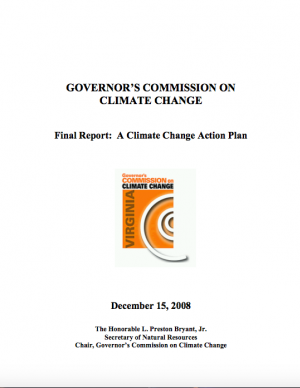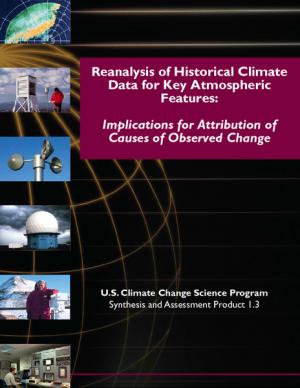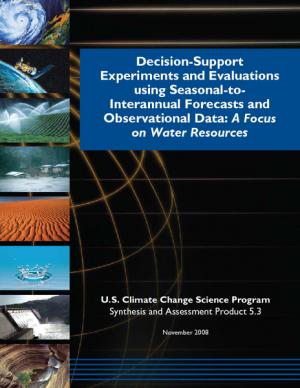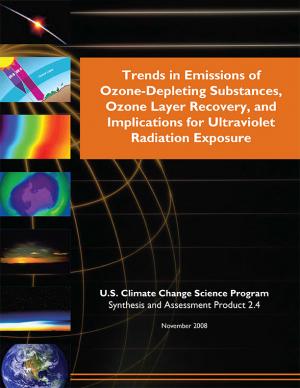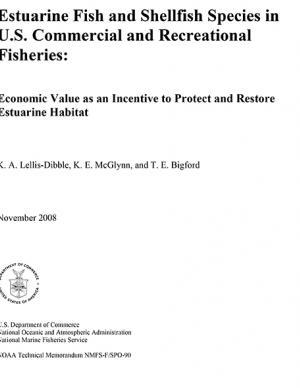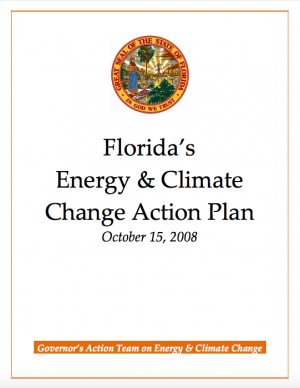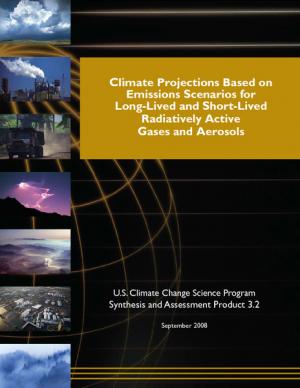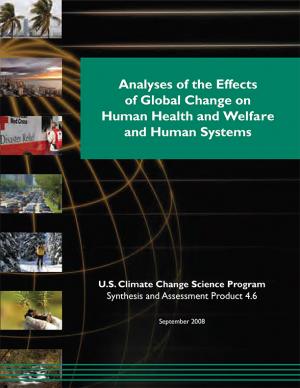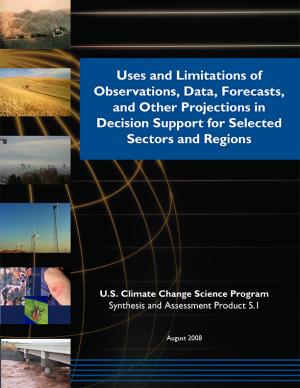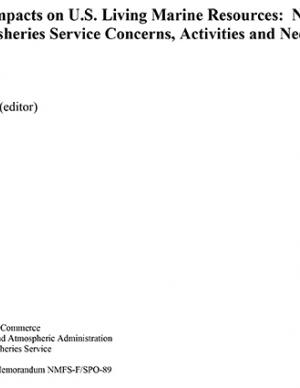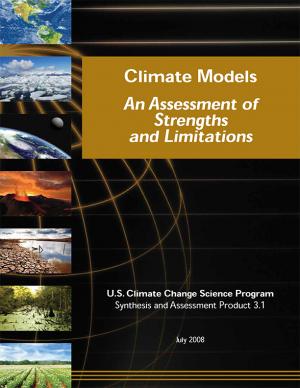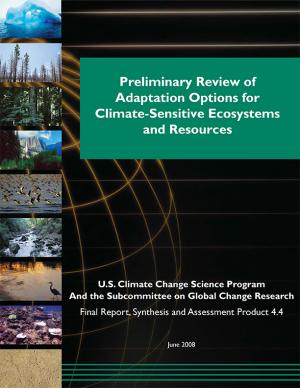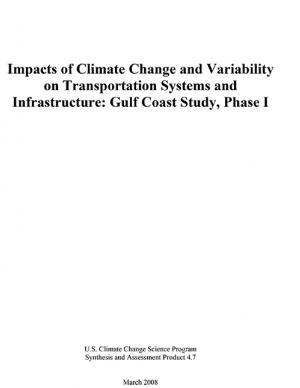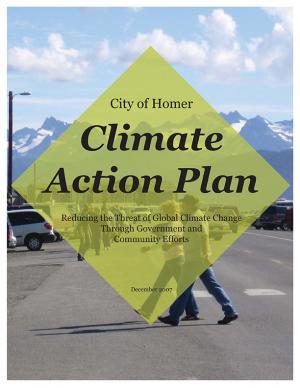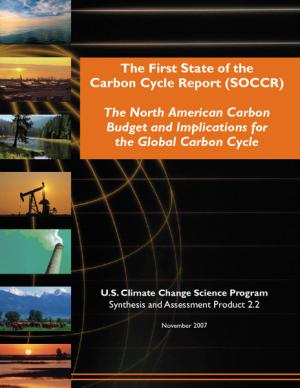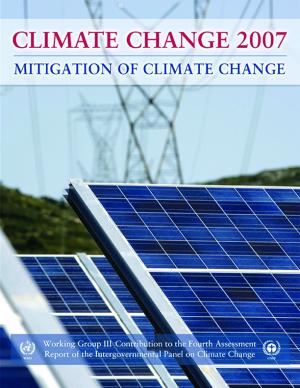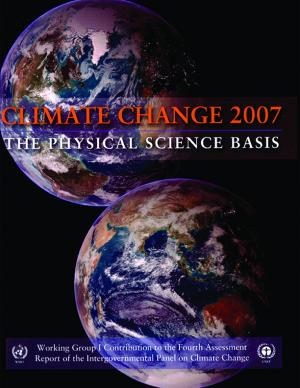Access a range of climate-related reports issued by government agencies and scientific organizations. Browse the reports listed below, or filter by scope, content, or focus in the boxes above. To expand your results, click the Clear Filters link.
The Action Plan describes climate effects on the built environment, natural systems, and human health in Virginia and sets forth a comprehensive set of recommendations for reducing greenhouse gases.
This reanalysis combines a diverse array of past observations together within a model to derive a best estimate of how the climate system has evolved over time. The goal is to provide consistent and reliable long-term datasets of temperatures, precipitation, winds, and many other climate variables. The report is a Synthesis and Assessment Product developed as part of the U.S. Climate Change Science Program.
In 2008, the Iowa General Assembly created the Iowa Climate Change Advisory Council (ICCAC), consisting of 23 voting members appointed by the state's governor. The ICCAC was tasked with developing a greenhouse gas emission reduction proposal to the governor and the general assembly. This document is the council's final report.
Earth's climate varies naturally, and also changes in response to human activity. Our ability to adapt and respond to climate depends on our understanding of the system and how to incorporate this understanding into resource management decisions. This Synthesis and Assessment Product, developed as part of the U.S. Climate Change Science Program, offers an evaluation of decision support experiments that have used seasonal-to-interannual climate forecasts and observational data in the context of water resource management.
This Synthesis and Assessment Product, developed as part of the U.S. Climate Change Science Program, integrates knowledge of the stratospheric ozone layer, human-emitted ozone-depleting substances, and the amount of harmful ultraviolet radiation reaching Earth's surface.
An analysis of the economic value of commercial and recreational fisheries in the United States.
This plan contains 50 separate policy recommendations to reduce harmful greenhouse gas emissions. The report estimates that if all its recommendations were implemented, the state would meet its emissions reduction targets, enjoy increased energy security, and see a net cost savings of more than $28 billion from 2009 to 2025.
Governor Mike Beebe established the Governor’s Commission on Global Warming, representing a wide diversity of views with members from business, industry, environmental groups, and academia. The commission was charged with moving Arkansas in the right direction to start stabilizing global climate, allow Arkansas to lead the nation in attracting clean and renewable energy industries, and to reduce consumer energy dependence on current carbon-generating technologies and expenditures. This document is the commission's final report.
In 2002, North Carolina's Governor Hunt signed the Clean Smokestack Act, which tasked the North Carolina Department of Environment and Natural Resources’ Division of Air Quality with studying options for reducing carbon dioxide emissions from coal-burning power plans and other sources. This report provides the Division's recommended mitigation options for reducing North Carolina’s carbon emissions.
This Synthesis and Assessment Product, developed as part of the U.S. Climate Change Science Program, is an assessment of the effects of short-lived gases and particles in the atmosphere, which can significantly change regional surface temperatures. By the year 2100, short-lived gases and particles may account for as much as 40 percent of the warming over the continental U.S. in summertime.
This Synthesis and Assessment Product from the U.S. Climate Change Science Program reviews impacts of global climate change on three broad dimensions of the human condition: human health, human settlements, and human welfare. This report examines opportunities for adaptation and associated recommendations for addressing data gaps and near- and long-term research goals.
Scientific information about Earth's climate, water, air, land, and other dynamic processes is essential for our understanding of humankind's relationship to our natural resources and our environment. This Synthesis and Assessment Product, developed as part of the U.S. Climate Change Science Program, examines contributions of Earth science information in decision support activities and their relationship to climate change science.
A report on climate impacts on coastal and marine ecosystems as it relates to the National Marine Fisheries Service's work.
This report offers recommendations to protect Maryland’s future economic well-being, environmental heritage, and public safety from the impacts of sea level rise.
Scientists use mathematical models of Earth's climate, run on the most powerful computers available, to examine hypotheses about past and present-day climates. This Synthesis and Assessment Product, developed as part of the U.S. Climate Change Science Program, describes the models and their ability to simulate climate.
The Global Warming Task Force was created by Wisconsin Governor Jim Doyle in April 2007. The Task Force created this report, which contains its policy recommendations to reduce greenhouse gas emissions in Wisconsin, as well as its short- and long-term goals for reducing greenhouse gas emissions in the state.
In February of 2007, Governor Sanford of South Carolina established the Governor’s Climate, Energy, and Commerce Committee to develop a Climate, Energy, and Commerce Action Plan containing specific recommended actions for mitigating greenhouse gas emissions. This document is the committee's action plan, which documents its recommendations and associated analyses to reduce greenhouse gas emissions and enhance energy and economic policy in South Carolina by 2020 and beyond.
This Synthesis and Assessment Product, developed as part of the U.S. Climate Change Science Program, offers a review of adaptation options for climate-sensitive ecosystems and resources in the United States. This report focuses on the following selected land management systems: National Forests, National Parks, National Wildlife Refuges, Wild and Scenic Rivers, National Estuaries, and Marine Protected Areas.
Ted Kulongoski, Governor of Oregon from 2003–2011, selected the Climate Change Integration Group (CCIG) to develop a framework for making informed decisions to minimize the more extreme impacts of climate change. Kulongoski wanted the CCIG to create a strategy for Oregon to apply the measures from the 2004 Oregon Strategy for Greenhouse Gas Reductions. In this report, the CCIG proposes that Oregon takes steps toward developing a framework that will assist individuals, businesses, and governments to incorporate climate change into their planning processes.
Vermont's Governor James Douglas established the Governor’s Commission on Climate Change by executive order on December 5, 2005. The state's goal, as outlined in this document, is to reduce its greenhouse gas emissions by 25 percent from 1990 levels by 2012, 50 percent by 2028, and 75 percent by 2050.
There is robust consensus that human-induced climate change is occurring. This Synthesis and Assessment Product from the U.S. Climate Change Research Program is an assessment of the effects of climate change on U.S. land resources, water resources, agriculture, and biodiversity.
In 2007, Nevada's Governor Jim Gibbons signed an executive order that created the Nevada Climate Change Advisory Committee. The order directed the committee to propose recommendations to further reduce greenhouse gas emissions in Nevada, and tasked it with writing this three-part report highlighting the potential impacts, accomplishments, and recommendations to address the issue of climate change in Nevada.
In 2006, Minnesota Governor Tim Pawlenty announced the “Next Generation Energy Initiative,” which included the “development of a comprehensive plan to reduce Minnesota’s emissions of greenhouse gases.” During this announcement, the governor requested that the Center for Climate Strategies help in the development of Minnesota's Climate Mitigation Action Plan and the formation of the Minnesota Climate Change Advisory Group. The Climate Change Advisory Group, which was tasked with developing a comprehensive set of state-level policy recommendations to the governor, produced this report.
As global temperatures increase, sea levels rise, and weather patterns change, the stewards of our nation's infrastructure are challenged to consider how these changes may affect the country's roads, airports, rail, transit systems, and ports. This study focuses on potential impacts of climate change on human infrastructure in the U.S. Gulf Coast region.
This report, a Synthesis and Assessment Product from the U.S. Climate Change Science Program, summarizes the effects of climate change on energy production and use in the United States. It also identifies where research could reduce uncertainties about vulnerabilities, possible effects, and strategies to reduce negative effects and increase adaptive capacity.
This plan—the first in Alaska—was developed by Homer's Global Warming Task Force and includes an inventory of greenhouse gas emissions from city facilities and community-wide, sets targets for reduction, and presents strategies for reducing emissions.
This Synthesis and Assessment Product from the U.S. Climate Change Science Program provides a synthesis of the then-current knowledge of North America's carbon budget and its context within the global carbon cycle. The report provides scientific information for decision support focused on key issues for carbon management and policy.
The Montana Climate Change Advisory Committee, established by the state's Department of Environmental Quality, evaluated greenhouse gas reduction opportunities in various places in Montana’s economy. The committee agreed upon the 54 policy recommendations described in this Climate Change Action Plan, designed to help reduce Montana’s emissions of heat-trapping greenhouse gases to 1990 levels by the year 2020.
This report summarizes scientific understandings of climate change and its potential impact on Utah and the western United States, created by a "blue ribbon" advisory council appointed by Utah Governor Huntsman. The report makes around 70 recommendations for fighting global warming, including developing significant amounts of renewable energy with incentives and tax credits, encouraging the capture and disposal of carbon dioxide, improving efficiency at power plants, implementing an aggressive mass transit strategy, and preserving open space and agricultural land and protecting forests. The report, however, does not include specific policy recommendations or rules to implement action.
In 2006, Illinois Governor Blagojevich launched the state's Global Warming Initiative by executive order that created the Illinois Climate Change Advisory Group. The group's purpose was to recommend state-level strategies to meet Illinois’ greenhouse gas reduction goals, which are similar to those set by other states and those proposed in Congress: 1990 levels by 2000, and 60 percent below 1990 levels by 2050. This document is the Advisory Group's report submitted to the governor.
The findings presented in this Synthesis and Assessment Product from the U.S. Climate Change Science Program draw from scenarios designed to stabilize the influence of a suite of greenhouse gases. Three climate-modeling groups independently developed a reference scenario and then developed four contrasting stabilization scenarios for comparison.
This report summarizes findings from a review of coastal hazards associated with sea level rise, hurricanes, nor'easters, and reduced sediment supply. The study also evaluates existing policies and potential knowledge gaps, and develops potential adaptation policies.
This comprehensive scientific assessment, representing the contribution of Working Group III to the Fourth Assessment Report of the Intergovernmental Panel on Climate Change, provides an in-depth analysis of the costs and benefits of different approaches to mitigating and avoiding climate change.
This comprehensive scientific assessment of past, present, and future global climate change represents the Intergovernmental Panel on Climate Change (IPCC) Working Group I's contribution to the IPCC Fourth Assessment report (AR4). The assessment confirms that the scientific understanding of the climate system and its sensitivity to greenhouse gas emissions is richer and deeper than ever before. The chapters forming the bulk of this report describe scientists' assessment of the then state-of-knowledge in their respective fields.
In June 2005, Governor Bill Richardson signed an executive order establishing the New Mexico Climate Change Advisory Group, and directed the group to prepare this report. It includes a projection of the state’s future greenhouse gas emissions and recommendations for policy changes to aid in the reduction of New Mexico’s total greenhouse gas emissions to 2000 levels by 2012, 10 percent below 2000 by 2020, and 75 percent by 2050.
Enacted in 2003, Maine's Public Law 237 required the state's Department of Environmental Protection to develop and submit this Climate Action Plan. The CAP includes plans to reduce greenhouse gas emissions to 1990 levels by 2010 and to 10 percent below 1990 levels in 2020.

